Effects of Urban Parks on Housing Prices in the Post-COVID-19 Pandemic Era in China
Abstract
1. Introduction
2. Materials and Methods
2.1. Study Area and Data
2.1.1. Study Area
2.1.2. Data Preparation
2.2. Method
2.3. Subsection and Quantification of Variables
3. Results and Analysis
4. Discussion
5. Conclusions
Author Contributions
Funding
Data Availability Statement
Acknowledgments
Conflicts of Interest
References
- Zambrano-Monserrate, M.A.; Ruano, M.A.; Yoong-Parraga, C.; Silva, C.A. Urban green spaces and housing prices in developing countries: A Two-stage quantile spatial regression analysis. For. Policy Econ. 2021, 125, 102420. [Google Scholar] [CrossRef]
- Dell’anna, F.; Bravi, M.; Bottero, M. Urban Green infrastructures: How much did they affect property prices in Singapore? Urban For. Urban Green. 2022, 68, 127475. [Google Scholar] [CrossRef]
- Zhou, C.; An, Y.; Zhao, J.; Xue, Y.; Fu, L. How do mini-parks serve in groups? A visit analysis of mini-park groups in the neighbourhoods of Nanjing. Cities 2022, 129, 103804. [Google Scholar] [CrossRef]
- Chwiałkowski, C.; Zydroń, A. Socio-Economic and Spatial Characteristics of Wielkopolski National Park: Application of the Hedonic Pricing Method. Sustainability 2021, 13, 5001. [Google Scholar] [CrossRef]
- Zhou, K.; Song, Y.; Tan, R. Public perception matters: Estimating homebuyers’ willingness to pay for urban park quality. Urban For. Urban Green. 2021, 64, 127275. [Google Scholar] [CrossRef]
- Kolimenakis, A.; Solomou, A.D.; Proutsos, N.; Avramidou, E.V.; Korakaki, E.; Karetsos, G.; Kontogianni, A.B.; Kontos, K.; Georgiadis, C.; Maroulis, G.; et al. Public Perceptions of the Socioeconomic Importance of Urban Green Areas in the Era of COVID-19: A Case Study of a Nationwide Survey in Greece. Land 2022, 11, 2290. [Google Scholar] [CrossRef]
- Yang, L.; Liang, Y.; He, B.; Lu, Y.; Gou, Z. COVID-19 effects on property markets: The pandemic decreases the implicit price of metro accessibility. Tunn. Undergr. Space Technol. 2022, 125, 104528. [Google Scholar] [CrossRef]
- Morancho, A.B. A hedonic valuation of urban green areas. Landsc. Urban Plan. 2003, 66, 35–41. [Google Scholar] [CrossRef]
- Tyrväinen, L.; Miettinen, A. Property Prices and Urban Forest Amenities. J. Environ. Econ. Manag. 2000, 39, 205–223. [Google Scholar] [CrossRef]
- Liebelt, V.; Bartke, S.; Schwarz, N. Urban Green Spaces and Housing Prices: An Alternative Perspective. Sustainability 2019, 11, 3707. [Google Scholar] [CrossRef]
- Trojanek, R.; Gluszak, M.; Tanas, J. The effect of urban green spaces on house prices in warsaw. Int. J. Strat. Prop. Manag. 2018, 22, 358–371. [Google Scholar] [CrossRef]
- Daams, M.N.; Sijtsma, F.J.; Veneri, P. Mixed monetary and non-monetary valuation of attractive urban green space: A case study using Amsterdam house prices. Ecol. Econ. 2019, 166, 106430. [Google Scholar] [CrossRef]
- Su, S.; He, S.; Sun, C.; Zhang, H.; Hu, L.; Kang, M. Do landscape amenities impact private housing rental prices? A hierarchical hedonic modeling approach based on semantic and sentimental analysis of online housing advertisements across five Chinese megacities. Urban For. Urban Green. 2021, 58, 126968. [Google Scholar] [CrossRef]
- Luttik, J. The value of trees, water and open space as reflected by house prices in the Netherlands. Landsc. Urban Plan. 2000, 48, 161–167. [Google Scholar] [CrossRef]
- Michael, T.; Vicky, L.; Michael, J. Residential Real Estateprices: A Room with a View. J. Real Estate Res. 2002, 23, 129–137. [Google Scholar]
- Jim, C.; Chen, W.Y. External effects of neighbourhood parks and landscape elements on high-rise residential value. Land Use Policy 2010, 27, 662–670. [Google Scholar] [CrossRef]
- Yoon, H. When and where do we see the proximity effect of a new park? –A case study of the Dream Forest in Seoul, Korea. J. Environ. Plan. Manag. 2018, 61, 1113–1136. [Google Scholar] [CrossRef]
- Kim, H.-S.; Lee, G.-E.; Lee, J.-S.; Choi, Y. Understanding the local impact of urban park plans and park typology on housing price: A case study of the Busan metropolitan region, Korea. Landsc. Urban Plan. 2019, 184, 1–11. [Google Scholar] [CrossRef]
- Belcher, R.N.; Chisholm, R.A. Tropical Vegetation and Residential Property Value: A Hedonic Pricing Analysis in Singapore. Ecol. Econ. 2018, 149, 149–159. [Google Scholar] [CrossRef]
- Belcher, R.N.; Suen, E.; Menz, S.; Schroepfer, T. Shared landscapes increase condominium unit selling price in a high-density city. Landsc. Urban Plan. 2019, 192, 103644. [Google Scholar] [CrossRef]
- Donovan, G.H.; Prestemon, J.P.; Butry, D.T.; Kaminski, A.R.; Monleon, V.J. The politics of urban trees: Tree planting is associated with gentrification in Portland, Oregon. For. Policy Econ. 2021, 124, 102387. [Google Scholar] [CrossRef] [PubMed]
- Wu, C.; Du, Y.; Li, S.; Liu, P.; Ye, X. Does visual contact with green space impact housing pricesʔ An integrated approach of machine learning and hedonic modeling based on the perception of green space. Land Use Policy 2022, 115, 106048. [Google Scholar] [CrossRef]
- Sohn, W.; Kim, H.W.; Kim, J.-H.; Li, M.-H. The capitalized amenity of green infrastructure in single-family housing values: An application of the spatial hedonic pricing method. Urban For. Urban Green. 2020, 49, 126643. [Google Scholar] [CrossRef]
- Zhang, Y.; Zhang, T.; Zeng, Y.; Yu, C.; Zheng, S. The rising and heterogeneous demand for urban green space by Chinese urban residents: Evidence from Beijing. J. Clean. Prod. 2021, 313, 127781. [Google Scholar] [CrossRef]
- Cui, N.; Gu, H.; Shen, T.; Feng, C. The Impact of Micro-Level Influencing Factors on Home Value: A Housing Price-Rent Comparison. Sustainability 2018, 10, 4343. [Google Scholar] [CrossRef]
- Mao, D.; Wu, Y.; Yuan, Z.; Lu, Y.; Hu, X.; Que, S. Impact Analysis of Ecological Landscape on Housing Price in Changsha City. Econ. Geogr. 2018, 38, 76–82. [Google Scholar] [CrossRef]
- Huang, T.; He, Q.; Yang, D.; Ouyang, X. Evaluating the Impact of Urban Blue Space Accessibility on Housing Price: A Spatial Quantile Regression Approach Applied in Changsha, China. Front. Environ. Sci. 2021, 9, 696626. [Google Scholar] [CrossRef]
- Espey, M.; Lopez, H. The Impact of Airport Noise and Proximity on Residential Property Values. Growth Chang. 2000, 31, 408–419. [Google Scholar] [CrossRef]
- Panduro, T.E.; Veie, K.L. Classification and valuation of urban green spaces—A hedonic house price valuation. Landsc. Urban Plan. 2013, 120, 119–128. [Google Scholar] [CrossRef]
- Leggett, C.G.; Bockstael, N.E. Evidence of the Effects of Water Quality on Residential Land Prices. J. Environ. Econ. Manag. 2000, 39, 121–144. [Google Scholar] [CrossRef]
- Kim, C.W.; Phipps, T.T.; Anselin, L. Measuring the benefits of air quality improvement: A spatial hedonic approach. J. Environ. Econ. Manag. 2003, 45, 24–39. [Google Scholar] [CrossRef]
- Gallagher, D.R.; Jackson, S.E. Promoting community involvement at brownfields sites in socio-economically disadvantaged neighbourhoods. J. Environ. Plan. Manag. 2008, 51, 615–630. [Google Scholar] [CrossRef]
- Hobden, D.W.; E Laughton, G.; E Morgan, K. Green space borders—A tangible benefit? Evidence from four neighbourhoods in Surrey, British Columbia, 1980–2001. Land Use Policy 2004, 21, 129–138. [Google Scholar] [CrossRef]
- Troy, A.; Grove, J.M. Property values, parks, and crime: A hedonic analysis in Baltimore, MD. Landsc. Urban Plan. 2008, 87, 233–245. [Google Scholar] [CrossRef]
- Iqbal, A.; Ceccato, V. Does crime in parks affect apartment prices? J. Scand. Stud. Criminol. Crime Prev. 2015, 16, 97–121. [Google Scholar] [CrossRef]
- Iqbal, A.; Wilhelmsson, M. Park proximity, crime and apartment prices. Int. J. Hous. Mark. Anal. 2018, 11, 669–686. [Google Scholar] [CrossRef]
- Crompton, J.L. The impact of parks on property values: Empirical evidence from the past two decades in the United States. Manag. Leis. 2005, 10, 203–218. [Google Scholar] [CrossRef]
- Liu, L.; Meng, L.; Zhang, R. Does Easy Accessibility to Urban Parks Always Raise Home Values? J. Hous. Econ. 2024, 63, 101981. [Google Scholar] [CrossRef]
- Xiao, Y.; Hui, E.C.; Wen, H. The housing market impacts of human activities in public spaces: The case of the square dancing. Urban For. Urban Green. 2020, 54, 126769. [Google Scholar] [CrossRef]
- Cheshire, P.; Sheppard, S. On the Price of Land and the Value of Amenities. In The Economics of Land Use; Routledge: London, UK, 2017; pp. 315–335. [Google Scholar] [CrossRef]
- Kim, J.-H.; Li, W.; Newman, G.; Kil, S.-H.; Park, S.Y. The influence of urban landscape spatial patterns on single-family housing prices. Environ. Plan. B Urban Anal. City Sci. 2016, 45, 26–43. [Google Scholar] [CrossRef]
- Tajani, F.; Di Liddo, F.; Guarini, M.R.; Ranieri, R.; Anelli, D. An Assessment Methodology for the Evaluation of the Impacts of the COVID-19 Pandemic on the Italian Housing Market Demand. Buildings 2021, 11, 592. [Google Scholar] [CrossRef]
- Sari, M.; Fatimah, I.S.; Pratiwi, P.I.; Sulistyantara, B. Psychological Effects of Walking and Relaxed Sitting in Urban Greenspaces During Post-pandemic: A Case Study in Bogor City, Indonesia. J. Contemp. Urban Aff. 2023, 7, 1–17. [Google Scholar] [CrossRef]
- Rosa-Jimenez, C.; Jaime-Segura, C. Living Space Needs of Small Housing in the Post-Pandemic Era: Malaga as a case study. J. Contemp. Urban Aff. 2021, 6, 51–58. [Google Scholar] [CrossRef]
- Cheung, K.S.; Yiu, C.Y.; Xiong, C. Housing Market in the Time of Pandemic: A Price Gradient Analysis from the COVID-19 Epicentre in China. J. Risk Financial Manag. 2021, 14, 108. [Google Scholar] [CrossRef]
- Zhai, W.; Peng, Z.-R. Where to buy a house in the United States amid COVID-19? Environ. Plan. A Econ. Space 2020, 53, 9–11. [Google Scholar] [CrossRef]
- Chen, Y.; Luo, Z. Hedonic Pricing of Houses in Megacities Pre- and Post-COVID-19: A Case Study of Shanghai, China. Sustainability 2022, 14, 11021. [Google Scholar] [CrossRef]
- Ionascu, E. Romanian Housing Market before and during the COVID-19 Pandemic. In Innovative Models to Revive the Global Economy; Sciendo: Boston, MA, USA, 2020; pp. 96–105. [Google Scholar] [CrossRef]
- Slišković, T.; Sekur, T.; Beg, M. The COVID-19 Pandemic Effects on the Housing Market of the Northern and Pannonian Croatia. In Proceedings of the 11th International Scientific Symposium Region, Entrepreneurship, Development (RED 2022), Osijek, Hrvatska, 9–11 June 2022; pp. 708–727. [Google Scholar]
- Yang, M.; Zhou, J. The impact of COVID-19 on the housing market: Evidence from the Yangtze river delta region in China. Appl. Econ. Lett. 2022, 29, 409–412. [Google Scholar] [CrossRef]
- Li, M.; Peng, Y.; Wu, Y.; Xu, J.; Tan, T.; Guo, H.; Lu, W.; Yeh, A.G.O.; Xue, F. Role of the Built Environment in the Recovery From COVID-19: Evidence From a GIS-Based Natural Experiment on the City Blocks in Wuhan, China. Front. Built Environ. 2022, 7. [Google Scholar] [CrossRef]
- Coulson, E. Monograph on Hedonic Estimation and Housing Markets; Penn State University: State College, PA, USA, 2008. [Google Scholar]
- Soltani, A.; Pettit, C.J.; Heydari, M.; Aghaei, F. Housing price variations using spatio-temporal data mining techniques. J. Hous. Built Environ. 2021, 36, 1199–1227. [Google Scholar] [CrossRef]
- Huang, T.; He, Q.; Ouyang, X. The Capitalization Effect of Natural Amenities on Housing Price in Urban China: New Evidence From Changsha. Front. Environ. Sci. 2022, 10, 833831. [Google Scholar] [CrossRef]
- Heyman, A.V.; Sommervoll, D.E. House prices and relative location. Cities 2019, 95, 102373. [Google Scholar] [CrossRef]
- Hoover, F.-A.; Price, J.; Hopton, M. Examining the effects of green infrastructure on residential sales prices in Omaha, Nebraska. Urban For. Urban Green. 2020, 54, 126778. [Google Scholar] [CrossRef] [PubMed]



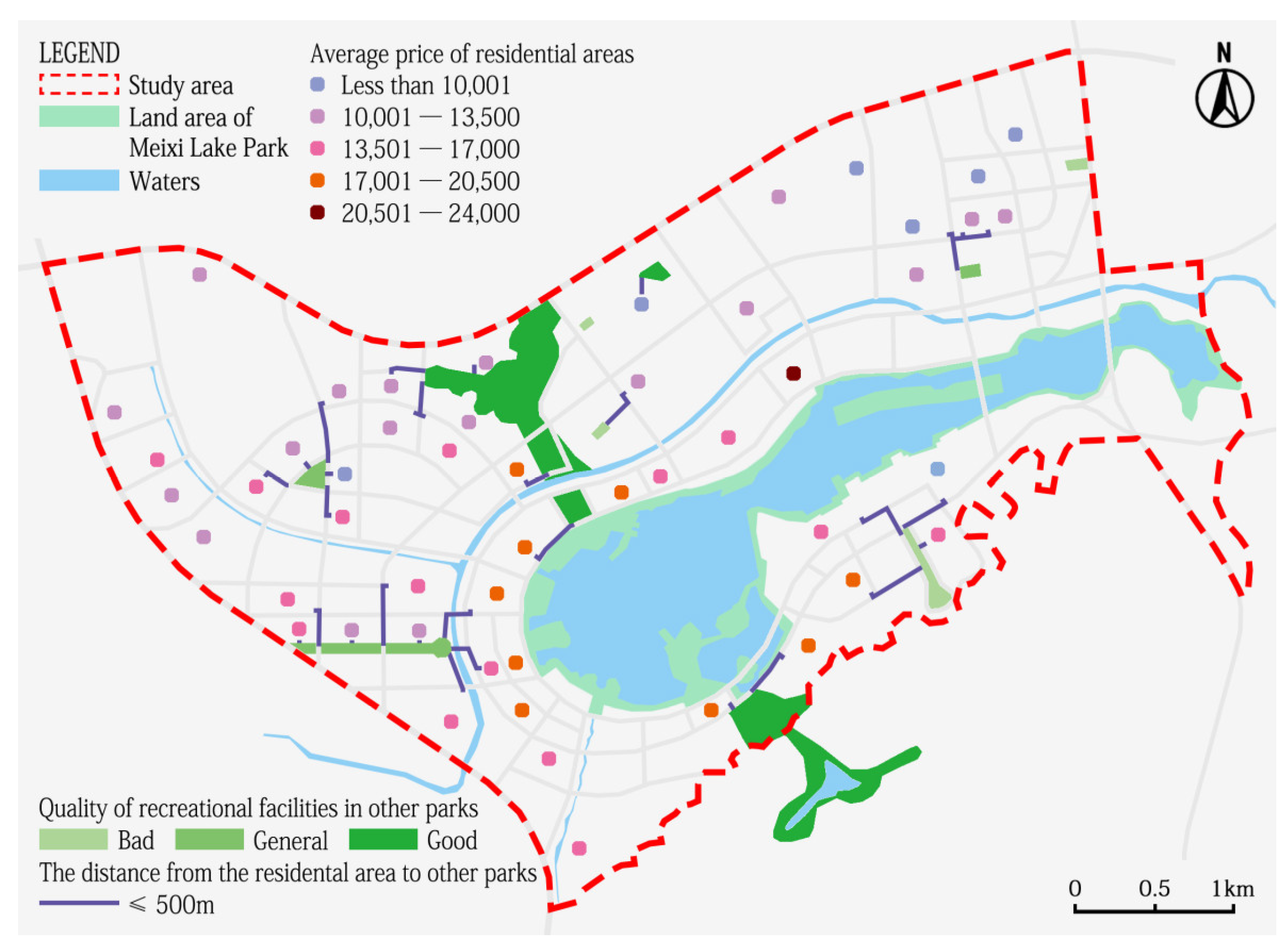






| Category | Variable | Variable Definition and Measuring Methods |
|---|---|---|
| Intrinsic | BA | Age of building in the residential area (year) |
| FAR | The floor area ratio of the residential area (%) | |
| GR | The greening rate of the residential area (%) | |
| FE | The assessment of the feeling of the residential area environment, mainly including the feeling of sanitary conditions and landscape view (bad = 1, neutral = 2, good = 3) | |
| PMS | The property management service costs of the residential area CNY/m2) | |
| Extrinsic | SS | The social service score, based on the number of restaurants, supermarkets, food markets, banks, and hospitals within 500 m of the residential area |
| ES | The education score, based on the number of kindergartens, primary schools, and middle schools within 500 m of the residential area | |
| DTS | The distance from the residential area to the nearest subway station (km) | |
| DTC | The distance from the residential area to the nearest commercial center (km) | |
| DTH | The distance from the residential area to the nearest public hospital (km) | |
| Especially those related to the park | DTM | The distance from the residential area to Meixi Lake park (km) |
| FM | The quality of recreational facilities in Meixi Lake park (bad = 1, neutral = 2, good = 3) | |
| LM | The feeling of the landscape view in Meixi Lake park (bad = 1, neutral = 2, good = 3) | |
| PN | Other parks within 500 m of the residential area (yes = 1, no = 0) | |
| DTP | The shortest walking distance from the residential area to the other park (km) | |
| AP | The area of the other park closest to the residential area (hm2) | |
| QFP | The quality of recreational facilities in other parks (bad = 1, neutral = 2, good = 3) | |
| LVP | The feeling of the landscape view in other parks (bad = 1, neutral = 2, good = 3) | |
| MV | The view of mountains (yes = 1, no = 0) | |
| LVM | The view of Meixi Lake park (yes = 1, no = 0) |
| Variable | Unit | Maximum | Minimum | Average | SD |
|---|---|---|---|---|---|
| Housing price (June 2020) | yuan/m2 | 22,319 | 7020 | 13,868.3 | 3490.462 |
| Housing price (June 2023) | yuan/m2 | 29,768 | 6363 | 16,716.8 | 5677.384 |
| Building age (June 2020) | year | 31 | 1 | 6.5 | 6.319 |
| Building age (June 2023) | year | 34 | 4 | 9.5 | 6.319 |
| Floor area ratio (FAR) | - | 7.9 | 1.2 | 3.4 | 1.355 |
| Greening rate | % | 60 | 20 | 38.5 | 7.244 |
| Residential environment | - | 3 | 1 | 1.8 | 0.775 |
| Property management service | yuan/m2 | 6.5 | 0.1 | 2.2 | 1.079 |
| Social service | - | 5 | 2 | 3.5 | 0.830 |
| School | - | 3 | 0 | 2.7 | 0.614 |
| Distance to subway station | km | 2.7 | 0.2 | 0.9 | 0.595 |
| Distance to commercial center | km | 4.1 | 0.2 | 2.1 | 0.888 |
| Distance to hospitals | km | 3.7 | 0.4 | 1.6 | 0.784 |
| Distance to Meixi Lake park | km | 2.9 | 0.1 | 1.1 | 0.694 |
| Facilities in Meixi Lake park | - | 3 | 1 | 2.4 | 0.869 |
| Landscape view of Meixi Lake park | - | 3 | 1 | 2.1 | 0.785 |
| Within 500 m of other parks | - | 1 | 0 | 0.66 | 0.474 |
| Distance to the other parks | km | 1.7 | 0.1 | 0.6 | 0.366 |
| Area of the other parks | hm2 | 290.7 | 0.26 | 32.2 | 76.756 |
| Facilities in the other parks | - | 3 | 1 | 2.3 | 0.608 |
| Landscape view of the other parks | - | 3 | 1 | 2.4 | 0.714 |
| Mountain view | - | 1 | 0 | 0.6 | 0.496 |
| Lake view | - | 1 | 0 | 0.4 | 0.494 |
| Functional Models | R | R2 | Adjusted R2 | F | Sig. | DW |
|---|---|---|---|---|---|---|
| Linear model | 0.907 | 0.822 | 0.700 | 6.716 | 0.000 | 1.657 |
| Semi-logarithmic model | 0.905 | 0.820 | 0.695 | 6.584 | 0.000 | 1.912 |
| Logarithmic model | 0.921 | 0.848 | 0.743 | 8.083 | 0.000 | 2.102 |
| Functional Models | R | R2 | Adjusted R2 | F | Sig. | DW |
|---|---|---|---|---|---|---|
| Linear model | 0.905 | 0.818 | 0.693 | 6.528 | 0.000 | 1.994 |
| Semi-logarithmic model | 0.912 | 0.831 | 0.714 | 7.127 | 0.000 | 2.080 |
| Logarithmic model | 0.913 | 0.834 | 0.719 | 7.269 | 0.000 | 2.210 |
| Variable | Denormalization Coefficient | Standardization Coefficient | Sig. | VIF |
|---|---|---|---|---|
| (Constant) | 3.979 *** | 0.000 | ||
| (In) PMS | 0.162 *** | 0.431 | 0.000 | 1.700 |
| (In) DTH | 0.180 *** | 0.343 | 0.000 | 1.151 |
| LM | 0.074 *** | 0.506 | 0.000 | 2.059 |
| PN | 0.038 ** | 0.157 | 0.034 | 1.104 |
| QFP | −0.037 ** | −0.197 | 0.014 | 1.246 |
| Variable | Regression Coefficient | Elasticity Coefficient (%) | Semi-Elasticity Coefficient (%) |
|---|---|---|---|
| (In) PMS | 0.162 | 0.162 | |
| (In) DTH | 0.180 | 0.180 | |
| LM | 0.074 | 7.681 | |
| PN | 0.038 | 3.873 | |
| QFP | −0.037 | −3.769 |
| Variable | Denormalization Coefficient | Standardization Coefficient | Sig. | VIF |
|---|---|---|---|---|
| (Constant) | 4.280 *** | 0.000 | ||
| (In) BA (June 2023) | −0.251 *** | −0.382 | 0.000 | 1.730 |
| (In) DTC | −0.126 ** | −0.191 | 0.028 | 1.208 |
| (In) DTH | 0.281 *** | 0.389 | 0.000 | 1.326 |
| (In) DTM | −0.123 ** | −0.252 | 0.011 | 1.523 |
| FM | 0.064 *** | 0.316 | 0.006 | 2.035 |
| Variable | Regression Coefficient | Elasticity Coefficient (%) | Semi-Elasticity Coefficient (%) |
|---|---|---|---|
| (In) BA (June 2023) | −0.251 | −0.251 | |
| (In) DTC | −0.126 | −0.126 | |
| (In) DTH | 0.281 | 0.281 | |
| (In) DTM | −0.123 | −0.123 | |
| FM | 0.064 | 6.609 |
| Classification | Satellite Map | Sketch Map | Situation | Meaning |
|---|---|---|---|---|
| 1 |  | 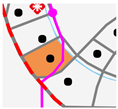 |  |
|
| 2 |  |  |  |
|
| 3 | 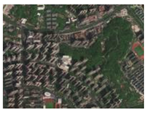 |  |  |
|
| 4 | 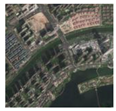 | 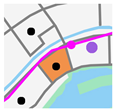 |  |
|
| 5 |  |  |  |
|
| 6 | 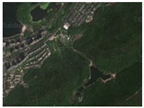 | 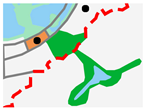 |  |
|
| 7 |  |  |  |
|
Disclaimer/Publisher’s Note: The statements, opinions and data contained in all publications are solely those of the individual author(s) and contributor(s) and not of MDPI and/or the editor(s). MDPI and/or the editor(s) disclaim responsibility for any injury to people or property resulting from any ideas, methods, instructions or products referred to in the content. |
© 2024 by the authors. Licensee MDPI, Basel, Switzerland. This article is an open access article distributed under the terms and conditions of the Creative Commons Attribution (CC BY) license (https://creativecommons.org/licenses/by/4.0/).
Share and Cite
Yang, X.; Ye, Q.; Peng, Y.; Liu, S.; Feng, T. Effects of Urban Parks on Housing Prices in the Post-COVID-19 Pandemic Era in China. Land 2024, 13, 519. https://doi.org/10.3390/land13040519
Yang X, Ye Q, Peng Y, Liu S, Feng T. Effects of Urban Parks on Housing Prices in the Post-COVID-19 Pandemic Era in China. Land. 2024; 13(4):519. https://doi.org/10.3390/land13040519
Chicago/Turabian StyleYang, Xinxing, Qiang Ye, You Peng, Shaobo Liu, and Tao Feng. 2024. "Effects of Urban Parks on Housing Prices in the Post-COVID-19 Pandemic Era in China" Land 13, no. 4: 519. https://doi.org/10.3390/land13040519
APA StyleYang, X., Ye, Q., Peng, Y., Liu, S., & Feng, T. (2024). Effects of Urban Parks on Housing Prices in the Post-COVID-19 Pandemic Era in China. Land, 13(4), 519. https://doi.org/10.3390/land13040519







